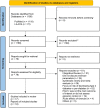Physical exercise as treatment for adults with type 2 diabetes: a rapid review
- PMID: 37842305
- PMCID: PMC10569299
- DOI: 10.3389/fendo.2023.1233906
Physical exercise as treatment for adults with type 2 diabetes: a rapid review
Abstract
Background: Type 2 diabetes mellitus (T2DM) is a leading cause of disability-adjusted life years (DALY). Physical exercise is an effective non-pharmacological intervention to promote glycaemic control in T2DM. However, the optimal exercise parameters for glycemic control in individuals with T2DM remain unclear.
Objective: This study aimed to analyze the relationship between physical training variables - frequency, intensity, type, duration, volume, and progression - and glycemic control in individuals with T2DM.
Methods: A rapid systematic literature review was conducted on PubMed and LILACS databases. The PICOT strategy was employed to define the inclusion criteria. Eligible studies had to assess the impact of exercise parameters (frequency, intensity, type, duration, volume, and progression) on glycemic control indicators, primarily glycosylated hemoglobin (HbA1c). Randomized and non-randomized clinical trials were included in the review. The methodological quality of each study was assessed using the PEDro scale (PROSPERO - CRD 42021262614).
Results: Out of 1188 papers initially identified, 18 reports met the inclusion criteria and were included in the analysis. A total of 1,228 participants with T2DM (1086 in exercise groups) were included in the selected studies. Among these studies, 16 (88.9%) were RCTs and 2 (11.1%) were nRCTs. The age of participants ranged from 43.1 and 68.9 years, and the average intervention duration was 16.8 weeks. Data on adherence to the intervention, adverse events, detailed intervention protocol, and its impacts on glycaemic control, lipid profile, blood pressure, anthropometric measures, medication, body composition, and physical fitness are reported.
Conclusion: The evidence supports the safety and effectiveness of physical exercises as non-pharmacological interventions for glycemic control. Aerobic, resistance and combined training interventions were associated with reductions in HbA1c and fasting glucose. The diversity of the physical exercise intervention protocols investigated in the studies included in this review is an important limitation to generalizing evidence-based practice. The call for action is mandatory to implement large-scale education programs on the prevention of diabetes and public health policies aimed to include well-planned and supervised exercise programs as an essential part of the primary prevention of type 2 diabetes.
Systematic review registration: PROSPERO, identifier (CRD42021262614).
Keywords: Noncommunicable diseases; diabetes mellitus; glycemic control; physical exercise, rehabilitation; physical fitness; primary health care; quality of life.
Copyright © 2023 Ribeiro, Carvalho and Bento-Torres.
Conflict of interest statement
The authors declare that the research was conducted in the absence of any commercial or financial relationships that could be construed as a potential conflict of interest.
Figures
Similar articles
-
The effectiveness of physical leisure time activities on glycaemic control in adult patients with diabetes type 2: A Systematic Review.JBI Libr Syst Rev. 2012;10(42 Suppl):1-20. doi: 10.11124/jbisrir-2012-251. JBI Libr Syst Rev. 2012. PMID: 27820154
-
Dose-response relationships of resistance training in Type 2 diabetes mellitus: a meta-analysis of randomized controlled trials.Front Endocrinol (Lausanne). 2023 Sep 25;14:1224161. doi: 10.3389/fendo.2023.1224161. eCollection 2023. Front Endocrinol (Lausanne). 2023. PMID: 37818093 Free PMC article.
-
The Impact of Physical Activity on Glycemic Variability Assessed by Continuous Glucose Monitoring in Patients With Type 2 Diabetes Mellitus: A Systematic Review.Front Endocrinol (Lausanne). 2020 Jul 31;11:486. doi: 10.3389/fendo.2020.00486. eCollection 2020. Front Endocrinol (Lausanne). 2020. PMID: 32903679 Free PMC article.
-
Exercise training modalities in patients with type 2 diabetes mellitus: a systematic review and network meta-analysis.Int J Behav Nutr Phys Act. 2018 Jul 25;15(1):72. doi: 10.1186/s12966-018-0703-3. Int J Behav Nutr Phys Act. 2018. PMID: 30045740 Free PMC article.
-
Study protocol: a randomised controlled trial of supervised resistance training versus aerobic training in Sri Lankan adults with type 2 diabetes mellitus: SL-DART study.BMC Public Health. 2018 Jan 24;18(1):176. doi: 10.1186/s12889-018-5069-6. BMC Public Health. 2018. PMID: 29368598 Free PMC article. Clinical Trial.
Cited by
-
Exploring the Role of Acute Exercise-Induced Myokine Release in Glucose Metabolism and Insulin Sensitivity in Healthy and Diabetic Individuals.Cureus. 2025 Feb 14;17(2):e78991. doi: 10.7759/cureus.78991. eCollection 2025 Feb. Cureus. 2025. PMID: 40091956 Free PMC article.
-
Current landscape and comprehensive management of glycemic variability in diabetic retinopathy.J Transl Med. 2024 Jul 29;22(1):700. doi: 10.1186/s12967-024-05516-w. J Transl Med. 2024. PMID: 39075573 Free PMC article. Review.
-
Association between circadian physical activity trajectories and incident type 2 diabetes in the UK Biobank.Sci Rep. 2024 Mar 18;14(1):6459. doi: 10.1038/s41598-024-57082-2. Sci Rep. 2024. PMID: 38499679 Free PMC article.
-
Aerobic exercise as a non-pharmacological intervention for improving metabolic and hemodynamic profiles in type 2 diabetes.Ir J Med Sci. 2024 Dec;193(6):2781-2790. doi: 10.1007/s11845-024-03783-6. Epub 2024 Aug 19. Ir J Med Sci. 2024. PMID: 39158674
-
The Power of Movement: Linking Physical Activity with Nutritional Health and Blood Sugar Balance in a Dalmatian Type 2 Diabetic Population.Nutrients. 2025 Jan 4;17(1):187. doi: 10.3390/nu17010187. Nutrients. 2025. PMID: 39796621 Free PMC article.
References
-
- International Diabetes Federation . IDF diabetes atlas (2021). Available at: www.diabetesatlas.org.
-
- Vos T, Lim SS, Abbafati C, Abbas KM, Abbasi M, Abbasifard M, et al. . Global burden of 369 diseases and injuries in 204 countries and territories, 1990–2019: a systematic analysis for the Global Burden of Disease Study 2019. Lancet (2020) 396(10258):1204–22. doi: 10.1016/S0140-6736(20)30925-9 - DOI - PMC - PubMed
-
- Cousin E, Schmidt MI, Ong KL, Lozano R, Afshin A, Abushouk AI, et al. . Burden of diabetes and hyperglycemia in adults in the Americas, 1990–2019: a systematic analysis for the Global Burden of Disease Study 2019. Lancet Diabetes Endocrinology. (2022) 10(9):655–67. doi: 10.1016/S2213-8587(22)00186-3 - DOI - PMC - PubMed
-
- Diabetes State Burden Toolkit Technical Report . Centers for disease control and prevention (2016). Available at: https://nccd.cdc.gov/Toolkit/DiabetesBurden/YLL/QALY.
-
- Riebe D, Ehrman JK, Liguori G, Magal M. ACSM’s guidelines for exercise testing and prescription. Tenth edition. Philadelphia, PA: American College of Sports Medicine’s guidelines for exercise testing and prescription. Philadelphia: Wolters Kluwer Health; (2018).
Publication types
MeSH terms
Substances
LinkOut - more resources
Full Text Sources
Medical
Miscellaneous


